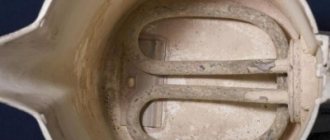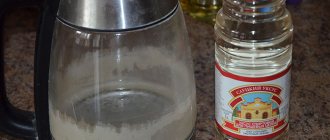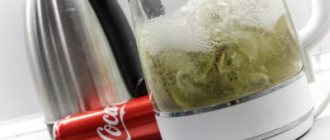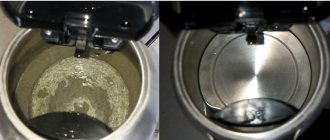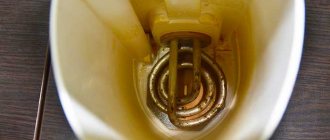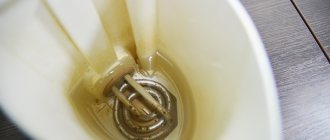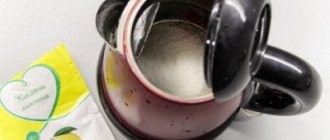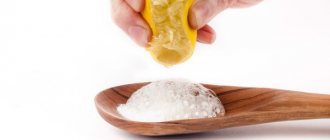A kettle is a must-have in every kitchen. Some people use an electric appliance or a thermopot, while some housewives prefer to boil water in a regular kettle on a gas or electric stove.
Whatever device you use, you have to deal with the fact that a white hard coating appears on its inner surface, which is called scale. It is formed due to the deposition of salts contained in tap water. When water boils, the salts decompose, forming a precipitate that cannot be dissolved, settles on the walls of the vessel and cannot be washed with a sponge and dishwashing detergent.
Scale is dangerous because when water boils, it releases many substances that can harm human health. And if you have a thermopot or an electric kettle in your kitchen, then deposits impair the quality of its operation; you cannot boil water in it; heating can lead to damage to the device. How to remove scale and get rid of plaque? The destruction of scale is caused by the active influence of substances of organic and inorganic origin that are present in acid-containing solutions. The most common method of descaling is cleaning with citric acid.
How does citric acid work?
The reason for the appearance of scale is the presence of magnesium and calcium salts in tap water, which, when decomposed, release carbon dioxide and solid compounds that do not dissolve when boiling.
Citric acid affects deposits of magnesium and calcium salts, and also interacts with carbonic acid, which is also present in scale.
Since citric acid is a substance with a stronger effect than carbonic acid, the latter is actively displaced. As a result, the chemical composition of the deposits changes, they become softer and are easier to remove from the walls of the dishes.
How to clean a kettle with citric acid and remove plaque inside? There are several ways.
Method for removing stubborn deposits in a kettle
If the natural methods we suggested for cleaning the kettle turned out to be ineffective, you can use ready-made chemicals available in household chemical stores. However, before purchasing, make sure they are suitable for use in cleaning food contact utensils. Otherwise, they may be hazardous to health. The price of such cleaning products is usually low.
If you want to drink clean water from your kettle, you must clean it regularly, at least once a month. Then you can invite guests for coffee or tea without worrying that they will find something more in the cup than your favorite drink.
Now you know how to clean a kettle at home from scale that is deposited on the walls inside. As you can see, the products available in every home are ideal for this purpose. It is only important to remember the frequency of cleaning. Otherwise, the layer will become very dense, practically insoluble. Then the kettle will have to be replaced with a new one.
How to clean a kettle using lemon?
Citric acid is suitable for cleaning both a regular kettle and a thermopot. You can use two methods: with heating and without heating.
Cleaning method without heating
Depending on how much deposits have formed, you will need 1-2 packs of citric acid for cleaning. You need:
- Fill the vessel 2/3 full with cold water.
- Add the required amount of substance.
- Leave for at least 4-5 hours.
After this, the water and acid are drained and the vessel is thoroughly washed. To remove the remaining substances, you need to boil clean water in a kettle 1-2 times.
Heat cleaning method
This method is suitable for cases when a lot of scale has formed. To remove it, you will need to follow the following procedure:
- Fill the kettle more than halfway with water.
- Add 2 packs of citric acid.
- Water with acid must be boiled for 5–7 minutes.
- Drain the water and rinse the vessel.
Before using the device, boil clean water in it several times. These methods are suitable for both a regular kettle and a thermopot with low to medium levels of contamination.
For cleaning electrical appliances made of plastic or stainless steel, these methods are effective. The situation is more complicated with ordinary enamel teapots; it often happens that citric acid alone is not enough to clean them, and it must be combined with other strong substances.
Cleaning the car cooling system
It is recommended to clean the car engine cooling system before each antifreeze change. This action gets rid of unwanted dirt, dust, and deposits from the cooling channels and surfaces of other parts; this is an excellent prevention of corrosion (this includes rust).
Citric acid is an ideal safe cleaner because it does not harm the skin or respiratory tract, and when used correctly, does not harm parts made of materials such as plastic, rubber, or soft metal. It is safe to clean a radiator made of any material to control its heating.
For cleansing, using 70-80 g of powder per 5 liters is sufficient. water. But in case of severe contamination, you will have to repeat the action several times.
Tips for cleaning your car's cooling system:
- use only distilled or cooled boiling water;
- First, the monohydrate is poured into a saucepan with ½ liter of liquid, boiled until completely dissolved, then the rest of the water is added;
- after removing the antifreeze, pour flushing into the heat exchanger, start the engine and warm it up to operating condition for 10-15 minutes;
- after turning off the engine, drain the cleaning solution and evaluate its color and consistency;
- The cleaning ends if the solution comes out clean, all that remains is to rinse with distilled water another 2-4 times.
Cleaning a regular kettle with citric acid and vinegar
In order to remove scale from the walls of a regular kettle, you will need 1 tablespoon of citric acid and ½ cup of vinegar (9%). Cleaning is carried out as follows:
- Fill the vessel halfway with water.
- Add vinegar and leave for 15-20 minutes.
- Then add citric acid and boil for half an hour.
- After this, remove the dishes from the heat and let the water sit for 25-30 minutes.
- Wash the kettle thoroughly with any detergent.
To avoid food poisoning, you need to boil water in a kettle at least three times.
Fresh lemon
An alternative to citric acid is juice squeezed from half a lemon.
The usage method is slightly different:
- Pour a glass of juice into the kettle, add water to the top (to the upper limit of limescale).
- Boil and let stand for about 60 minutes.
- We wash the walls very carefully.
They can also be grated with lemon by cutting the fruit into quarters.
Cleaning for particularly heavy soiling
How to descale a kettle with citric acid if the contamination is very strong and none of the above methods helped? In such cases, baking soda in combination with vinegar will help enhance the effect of the acid.
- Pour a full kettle of water.
- Add a tablespoon of soda and boil the solution (you need to boil for at least 5 minutes).
- Drain and refill the container with water.
- Add a tablespoon of citric acid and boil the solution over low heat for at least 30 minutes.
- Change the water again, adding half a glass of vinegar, and put the kettle to boil for 35–40 minutes.
After this, most of the scale will disappear, and you can get rid of the remaining residue by washing with a regular sponge. This method is only suitable for ordinary enamel teapots.
Scale in the kettle - can it be prevented?
Scale or yellowish limescale forms most often on the walls of teapots. Hard water is boiled in it several times a day. The stone is not only unsightly, its presence on the internal surfaces negatively affects the taste of coffee and tea prepared in the kettle. So we have to think about whether we can somehow prevent its occurrence.
Special filters are an effective but expensive method. However, these are expenses in the amount of more than one thousand rubles. On the market you can also find jugs with filters for settling water. The cheapest device of this type will also cost us a lot.
However, if you don't want to invest in new equipment, make sure to descale your kettle regularly. This procedure at home should be performed approximately every 1-2 months. The methods we offer below for removing scale from inside a kettle are a guarantee of daily success in caring for your kitchenware. You can also learn how to remove bad smells from your refrigerator. This problem also worries many housewives who strive to maintain perfect cleanliness in the kitchen.
Precautionary measures
How to get rid of scale without harming your health or damaging your appliance? Take the following precautions when cleaning your kettle or hotpot:
- Remember that you are using caustic substances and only work with gloves.
- When cleaning, the kettle is first filled with water, and only then can you add citric acid or vinegar.
- To clean an electrical appliance or thermopot, you can only use citric acid; soda and vinegar will ruin the device.
- When subsequently washing the vessel, do not use hard sponges, as this will damage the inner surface.
- To avoid the effects of harmful substances on the body, after cleaning you need to boil clean water in a vessel several times, and only then use it.
Cleaning must be carried out regularly, since scale occurs in any case, no matter how good the water purification systems you use, the only question is how long it takes to form. And to reduce the amount of deposits, regularly wash the inside of the appliance with a sponge and dishwashing detergent.
Causes of scale and its dangers
Scale is solid deposits consisting of insoluble and slightly soluble substances contained in water. Scale forms in all kettles without exception: most often it accumulates on the heating element, a little less often on the walls, and in particularly advanced cases - even in the upper part. Insoluble salts can have different compositions.
The amount of scale depends on the quality of the water used (hardness level and its chemical composition), as well as on the region where the water is obtained. The rate of plaque formation depends on several factors:
- the materials from which the kettle is made, in particular its heating element and walls;
- frequency of use of the device;
- the amount of chemical compounds in water.
Advice! It is best to use spring water or store-bought water for drinking and boiling.
There is debate about whether scale is beneficial or not. However, its harm is obvious, there is no need to argue about it. Firstly, the more precipitation there is, the worse the thermal conductivity coefficient becomes, therefore, more heat is required to heat water, and with it electricity or gas. Secondly, the kettle is deformed from the inside. When removing a deep layer of deposits, the surface of the device is severely damaged. Working in this mode, the kettle will quickly fail.
How much acid do you need?
On sale you can find 50 g bags of lemon juice. One is enough to clean the kettle. But if the volume is more than 1.5 liters, it is recommended to add another 25 g.
If you add too little powder, there will be no effect. Therefore, 10 g bags are not worth buying. It is more convenient to purchase a large package with 250 g of citric acid.
Important! The type of device does not affect the proportions. An electric kettle needs the same volume as a gas kettle. It is better to look not at the type of device, but at its volume. It depends on how much lemon you need.
Prevention measures
To prevent the appearance of scale and rust, it will not be superfluous to observe several points.
- After use, leave the kettles dry, pouring out all the water. Its remains produce calcium. It turns into scale and affects the walls of the products.
- Clean kettles at least monthly. The more often the procedure is performed, the less effort will have to be expended in the future. In addition, this will help maintain the functionality of the product for a long time.
- Boil only distilled water or purified water using a filter in a kettle.
- Rinse the kettle with a sponge after each use. This way you can remove scale at its initial stage.
There are many means and methods to help clean a kettle from scale. But their effectiveness will depend on how quickly you get to work.
The longer the kettle accumulates scale, the more time it will take to wash it. In any case, it is better to use proven methods, otherwise the risk of damaging the device increases.
Why descale your coffee machine?
The composition of clean, tasty water includes certain minerals and trace elements: calcium, magnesium, ferrous, potassium, chloride compounds. When heated, they form a limescale deposit, which gets into the coffee as white flakes and makes it tasteless, and ultimately threatens corrosion of the internal elements. The surface of the scale is porous, and microorganisms and bacteria quickly begin to multiply in it.
The maximum amount of plaque is formed by calcium dissolved in an aqueous environment, so the process of descaling a coffee machine is often called decalcification.
You can determine when it’s time to descale your coffee machine by the following signs:
- The smell of coffee changed, it became unpleasant and musty;
- The coffee is not strong enough or under-brewed;
- The steam pressure dropped noticeably;
- The sound of the coffee machine has changed.
Some coffee machines have automatic limescale check sensors. A flashing red indicator or message on the panel informs the user that it is time to decalcify.
